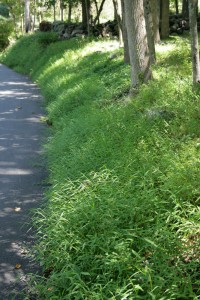Tip of the Week: Neighborhood Menace—Japanese Stilt Grass
Posted in Gardening Tips on September 13 2010, by Sonia Uyterhoeven
 |
Sonia Uyterhoeven is Gardener for Public Education. Join her each weekend for home gardening demonstrations on a variety of topics in the Home Gardening Center. |
 As I was walking into work recently, I bumped into Scott Mori, the Nathaniel Lord Britton Curator of Botany at the Garden. I mentioned to him that I had just attended a wonderful workshop given by NOFA Organic Land Care on the organic management of invasive plants in the landscape.
As I was walking into work recently, I bumped into Scott Mori, the Nathaniel Lord Britton Curator of Botany at the Garden. I mentioned to him that I had just attended a wonderful workshop given by NOFA Organic Land Care on the organic management of invasive plants in the landscape.
Scott mentioned that the biggest nuisance in his northern Westchester neighborhood is Japanese stilt grass (Microstegium vimineum). Approximately seven years ago he noticed a few plants along the roadside, several years latter the plants had formed a continuous band along each side of many of the roads, and today this pest is abundant in the woodland understory in his neighborhood. In addition, lawns are now also being invaded by this aggressive pest.
Japanese stilt grass is an annual grass indigenous to Japan, Korea, China, and India. It grows 2–3 feet tall and has a dense sprawling habit that gives it the capacity to smoother its neighbors. During the summer it colonizes an area by spreading along the ground via adventitious roots, which form from the nodes on its gangly stems.
Starting sometime in August until October it forms flowers and goes to seed. An individual plant can produce up to 1,000 seeds that will stay viable in the soil for up to seven years. This enormous seed bank allows this annual grass to keep them coming back year after year.
Japanese stilt grass can adapt to a variety of conditions. One thing that gives it an edge as a competitor in the natural world is its adaptability: It does well in low-light conditions and disturbed areas (it’s a good colonizer). You can find it flourishing in wetlands, woodlands, on utility easements, and in parks and lawns.
While the deer may devour everything else in your garden, they do not have a taste for this exotic grass. They do inadvertently help with the dissemination of the grass by spreading its seeds that stick to their fur and by eating surrounding native vegetation, which clears space for the stilt grass to grow.
The fight to control invasive species (to use the word “eradicate” is perhaps overly optimistic and unrealistic) begins with identifying goals. In regard to Japanese stilt grass, understanding its biology is important. Since it is an annual, the primary goal is to prevent seed production, and so the plants need to be removed before seeds can develop.
There are several ways to remove stilt grass, including hand-pulling, mowing, spraying, or burning. The method you choose should depend on where the grass is located and what would be the most effective and easiest way of tackling the problem. Next week, I will describe the nitty gritty of the removal process and look at these options in detail.
Tell us your stories of invasive species creeping into your neighborhood and how you have tried to combat them. We’ll post them to share with others.

